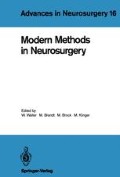Abstract
Space-occupying lesions of the brain stem may be documented by CT investigations. More detailed information on their location and extent can be acquired by magnetic resonance imaging (MRI) (1, 6). Strategy and operative risk can be better estimated when one knows the growth characteristics, whether cystic or exophytic tumor portions are present, and the relation of the tumor to surrounding structures (3, 7).
Access this chapter
Tax calculation will be finalised at checkout
Purchases are for personal use only
Preview
Unable to display preview. Download preview PDF.
References
Bradley WG, Waluch V, Yadley RA, Wycoff RR (1984) Comparison of CT and MR in 400 patients with suspected disease of the brain and cervical spinal cord. Radiology 152: 695–702
McGinnis BD, Brady TJ, New PFJ, Buonanno FS, Pykett IL, DeLaPaz RL, Kistler JP, Taveras JM (1983) Nuclear magnetic resonance (NMR) imaging of tumors in the posterior fossa. J Comput Assist Tomogr 7: 575–584
Han JS, Huss RG, Benson JE, Kaufman B, Yoon YS, Morrison SC, Alfidi RJ, Rekate HL, Ratcheson RA (1984) MR imaging of the skull base. J Comput Assist Tomogr 8: 944–952
Lee BCP, Kneeland JB, Deck MDF, Cahill PT (1984) Posterior fossa lesions: magnetic resonance imaging. Radiology 153: 137–143
Nadjmi M, Ratzka M (1986) Wann ist die NMR-Tomographie in der Diagnostik des zentralen Nervensystems unverzichtbar? In: Walter W, Krenkel W (eds) Jahrbuch der Neurochirurgie 1986. Regensberg und Biermann, Münster, pp 163–176
Randell CP, Collins AG, Young IR (1983) Nuclear magnetic resonance imaging of the posterior fossa. AJR 141: 489–496
Schorner E, Kazner E, Laniado M, Sprung C, Felix R (1984) Magnetic resonance tomography of intracranial tumors: initial experience with the use of the contrast medium gadolinium-DTPA. Neurosurg Rev 7: 303–312
Author information
Authors and Affiliations
Editor information
Editors and Affiliations
Rights and permissions
Copyright information
© 1988 Springer-Verlag Berlin Heidelberg
About this paper
Cite this paper
Brandt, M., Anagnostopoulos-Schleep, J., König, HJ., Fahrendorf, G., Herter, T. (1988). Advantages of MRI in the Surgical Strategy for Brain Stem Tumors. In: Walter, W., Brandt, M., Klinger, M., Brock, M. (eds) Modern Methods in Neurosurgery. Advances in Neurosurgery, vol 16. Springer, Berlin, Heidelberg. https://doi.org/10.1007/978-3-642-73294-2_30
Download citation
DOI: https://doi.org/10.1007/978-3-642-73294-2_30
Publisher Name: Springer, Berlin, Heidelberg
Print ISBN: 978-3-540-18708-0
Online ISBN: 978-3-642-73294-2
eBook Packages: Springer Book Archive

